July 11, 2025

Introducing DX NetOps Topology: What It Provides, How It Works
5 min read

Written by: Sandeep Tiwary
|
Key Takeaways
|
|
Networks aren’t what they used to be. While your network operations teams still have legacy equipment to manage, they’re also contending with the expanded reliance on software-defined networking (SDN), hybrid and multi-cloud architectures, private clouds, and more. These environments are anything but static. They’re sprawling, dynamic, and evolving faster than ever—which means that establishing and retaining visibility and control is more challenging than ever.
The new demands of the new network
In today’s networks, complexity is a given. You’re managing a multi-dimensional environment that’s constantly shifting. To keep pace, your operations teams need scalable tools that are simple to use and powerful enough to handle today’s demands. You need solutions that offer visibility that is aligned with the complex, dynamic nature of today’s network environments. This means harnessing solutions that address the following key requirements:
- Intelligent clustering. Teams must be able to use a range of criteria, including location, role, segment, organization, and criticality to establish groups of elements. This is essential in managing categories of network elements in a unified, consistent fashion, which promotes quality and efficiency.
- Layering. To gain an effective, holistic understanding of dynamic network environments, it is essential to be able to gain the right level of context and detail, at the right time. Teams need to establish different levels of abstraction, spanning from high-level representations to granular details. For example, if an administrator starts at a high-level view, and sees a domain is experiencing an issue, it is critical for them to be able to immediately drill down into the domain, locate the problem device, and access details to start identifying the root cause.
- Multi-dimensional navigation. Administrators must be able to view and navigate across various clusters and layers. This requires the ability to gain comprehensive visibility across different domains, locations, and technologies, while working within a unified, standard interface.
Introducing DX NetOps Topology
With DX NetOps, teams can centralize day-to-day operations to boost efficiency and control. Now, the solution features DX NetOps Topology. DX NetOps Topology transforms how network operations teams visualize, understand, and manage modern networks. The solution is built to simplify your daily workflow, speed up problem-solving, and scale right along with your environment.
With DX NetOps Topology, you can:
- Gain end-to-end visibility. Whether you’re managing legacy systems, cutting-edge SD-WAN deployments, or a mix of pretty much everything, DX NetOps Topology provides a unified view that brings it all together. You get a “single pane of glass” that offers coverage that spans clouds, locations, and technologies.
- Troubleshoot faster with multi-hop triage. Stop relying on trial and error and guesswork when issues arise. The platform’s multi-hop triage workflows help you follow the problem path, hop by hop—so you can figure out whether that device with a red alarm is the actual culprit, or just a symptom of a deeper issue.
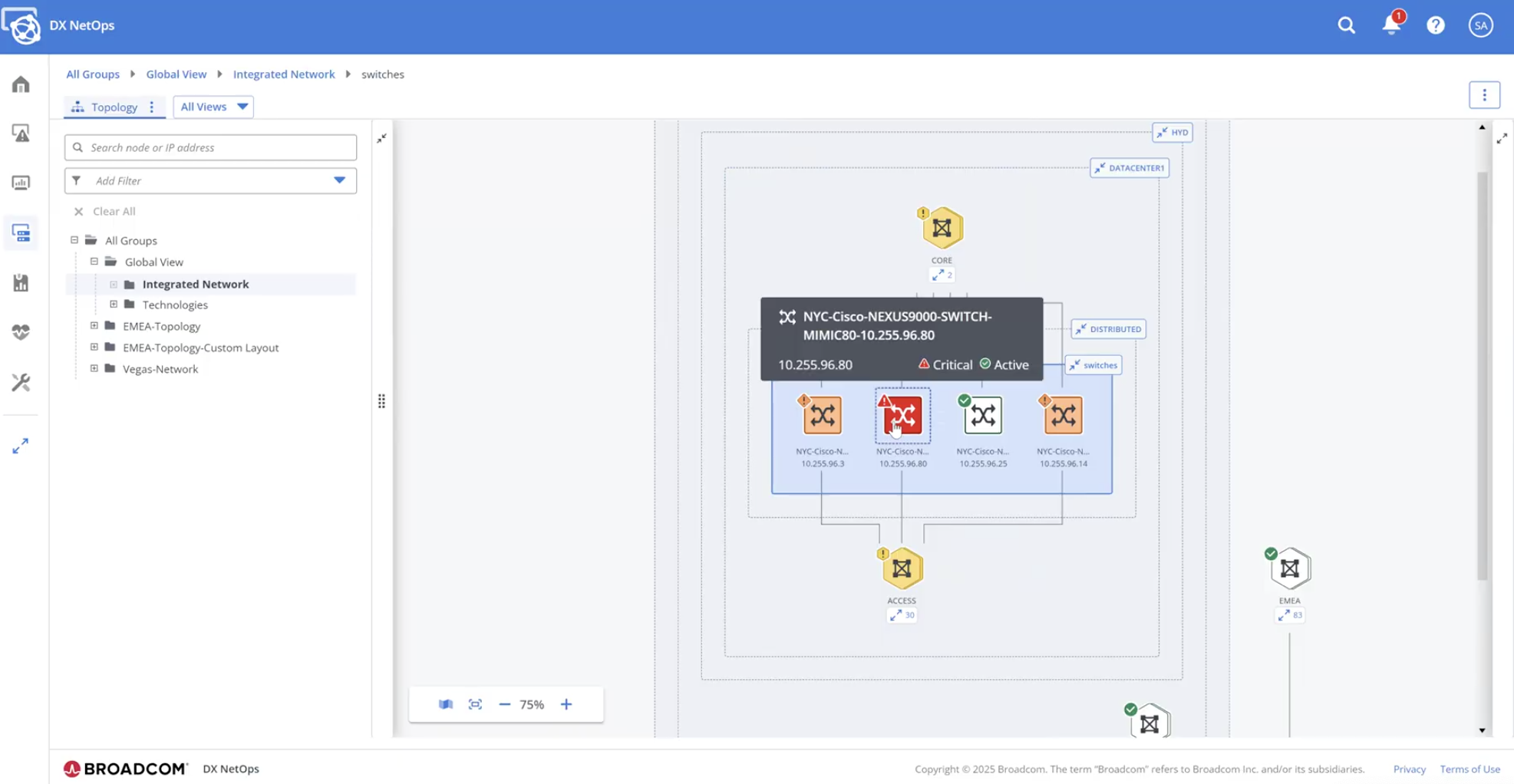
- Leverage intelligent, actionable views. Let’s say you’re troubleshooting an issue. You can either zoom in from a global view (top-down) or start with a known troubled device (bottom-up). And when it is time to act, you’re not left guessing. Every step in your navigation is packed with context—think alarms, metrics, port details—all shown right when you need them.
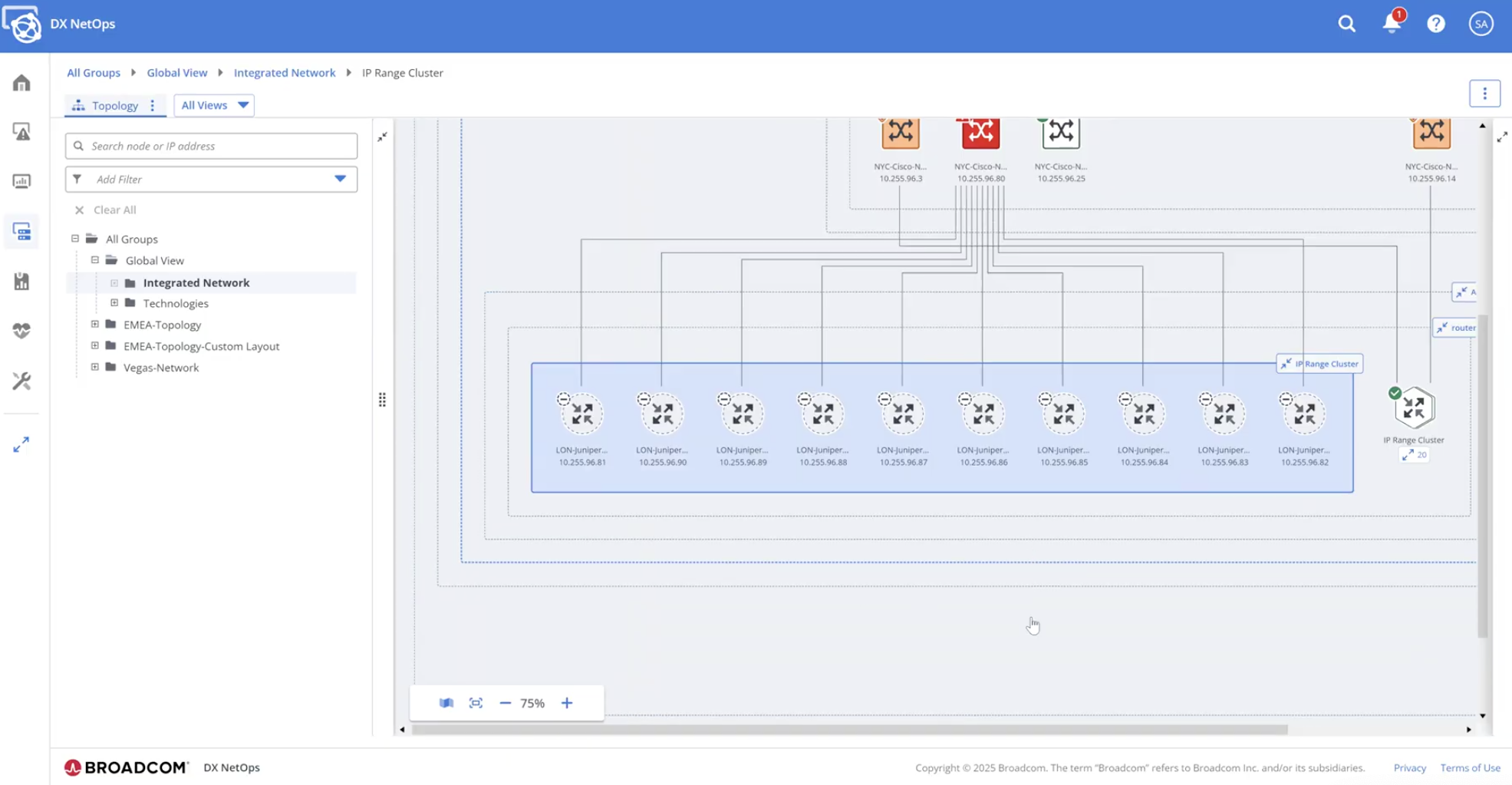
- Work smarter with intelligent clustering and layered views. You can organize elements by location, role, criticality, or any custom dimension you need. From a high-level overview to granular device details, layering gives you the control and perspective to dive deep when necessary—and do it quickly.
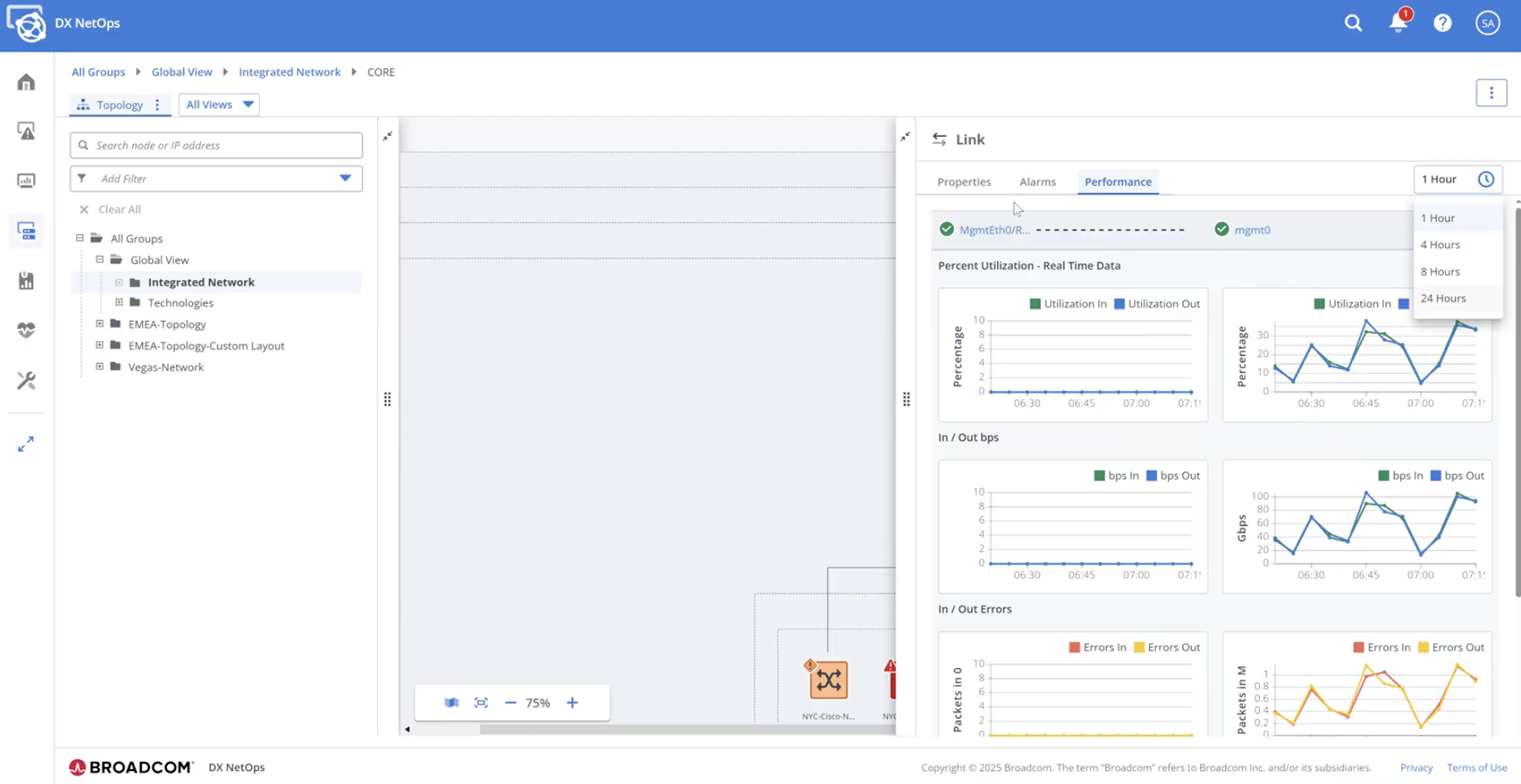
- Personalize your experience. Filters make it easy to narrow in by region, site, technology, or device type. You can even save those filtered views for later—so next time, you’re a click away from the insights you need.
- Stay ready for what comes next. With flexible integrations and a forward-looking roadmap, DX NetOps Topology is designed to grow with your organization, supporting emerging technologies and evolving infrastructures.
How it works
Once deployed, DX NetOps Topology becomes part of your inventory menu. Open it, and you’ll get a powerful visualization panel with zoom, search, and filtering tools. A detailed panel on the right gives you everything you need—alarms, metrics, port details, and more.
Whether you’re planning ahead or responding to a critical outage, this view gives you the clarity and control you need.
Example: Viptela SD-WAN
Managing SD-WAN? With DX NetOps Topology, you get unified, correlated views of both traditional and software-defined environments. For example, in a Viptela SD-WAN deployment that spans multiple locations, you can view the entire control and data plane. You’ll be able to:
- See physical routers, ports, and tunnels.
- Understand overlay and underlay relationships.
- Investigate issues quickly with a single click.
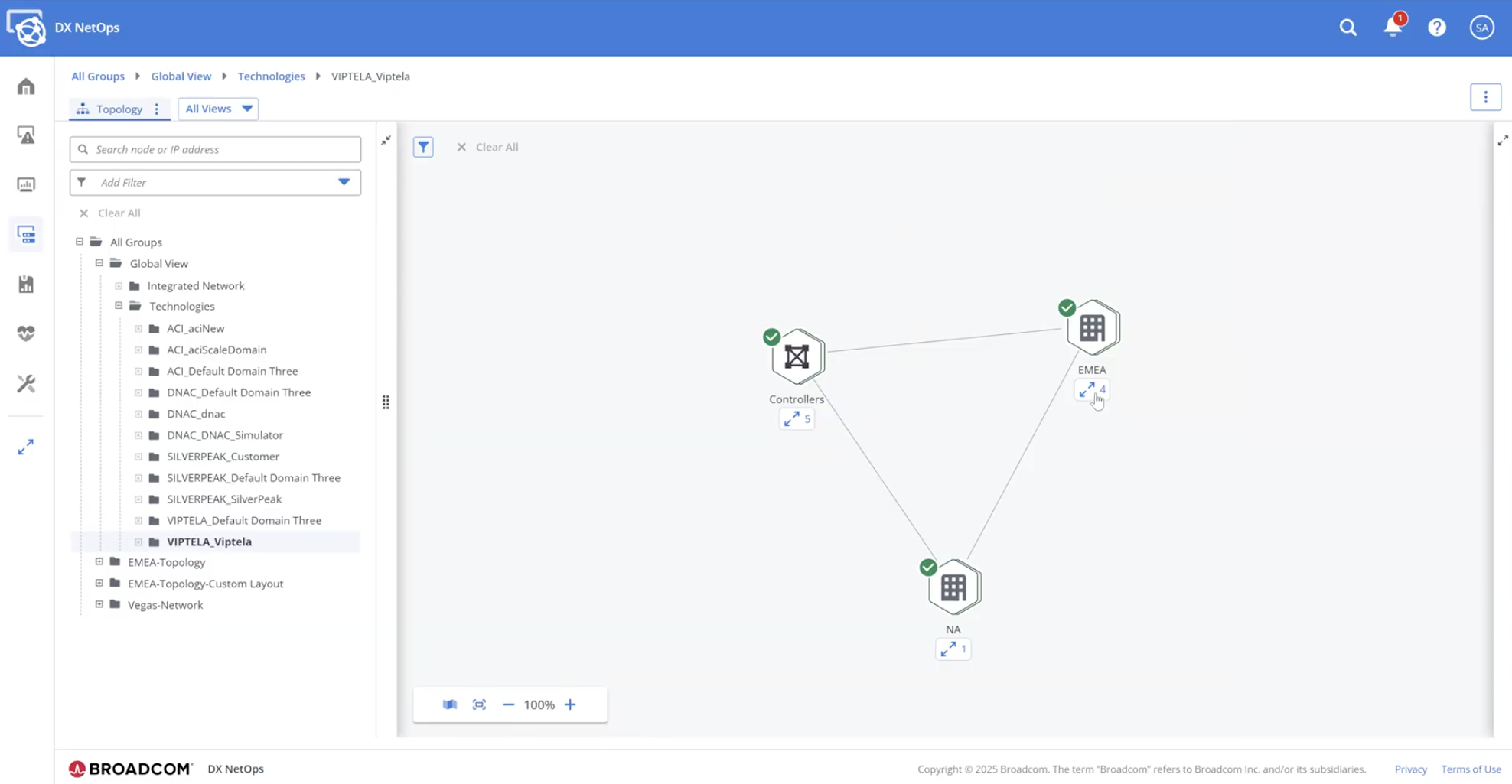
And it doesn’t stop with Viptela—DX NetOps Topology supports Cisco ACI, Cisco Catalyst Center, VMware NSX, and more.
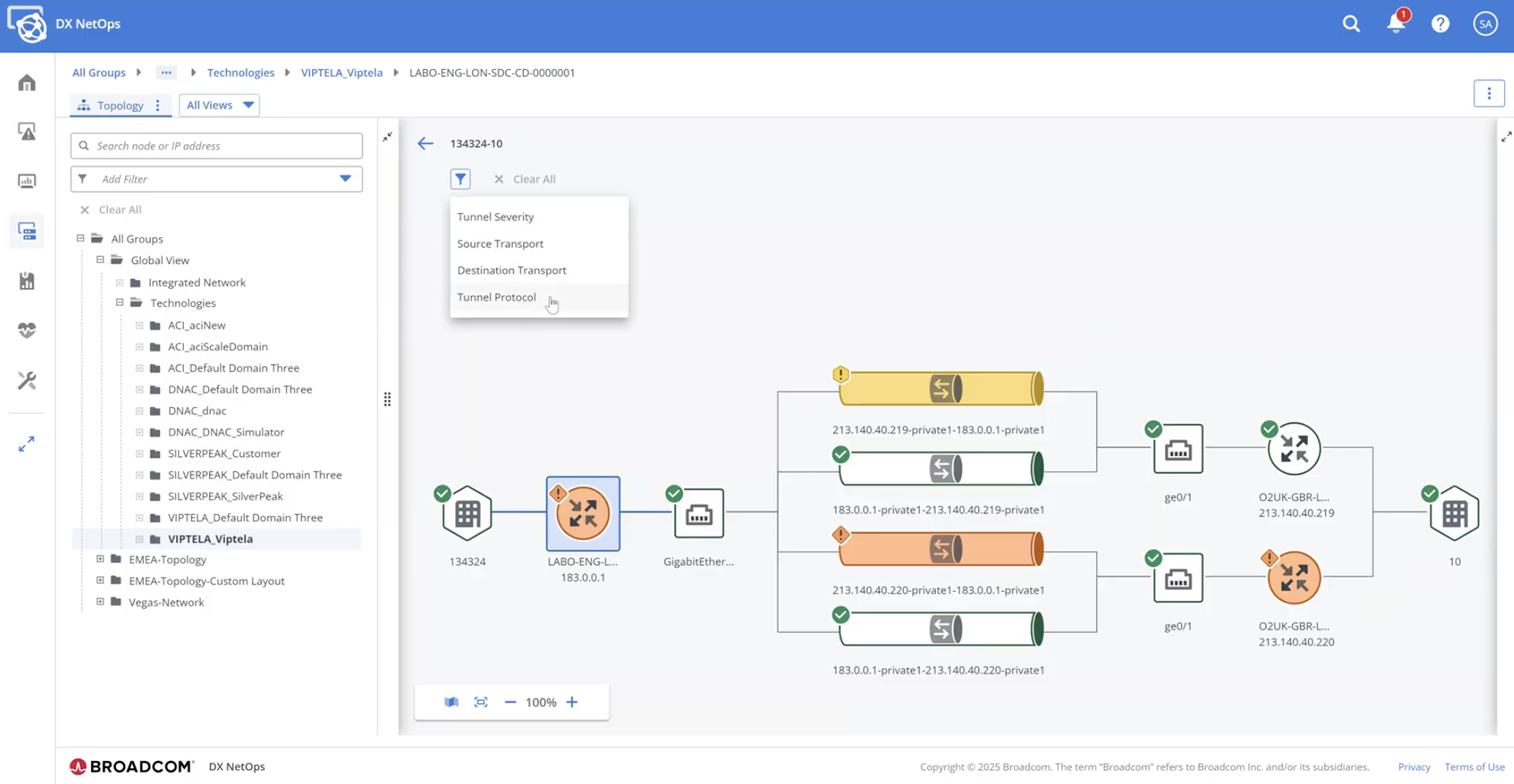
Conclusion
Today, networks are more dynamic, more complex, and more business-critical than ever. Your tools should be up to the task. DX NetOps Topology gives you the scalable visibility, intuitive workflows, and actionable insights you need to run your network with confidence. To learn more, be sure to view our recent Small Bytes webcast, A Comprehensive Overview of DX NetOps Topology.

Sandeep Tiwary
Sandeep Tiwary is a product manager for network operational intelligence for AIOps solutions at Broadcom. He has a deep understanding of and expertise in cloud technologies, along with more than 16 years of experience building and marketing software products and services. He is currently driving customer-centric...
Other resources you might be interested in
Top 3 Trends Defining Network Observability in 2026
Discover the three specific trends that will define network observability in 2026. See how unified observability and predictive AI will shape the landscape.
Why 2025 Shattered the Old Rules of Network Management
This post reveals the five key lessons network operations leaders learned in 2025—and how they need to respond to be successful in 2026.
The 2026 VMUG Report: Why Network Observability is the Heart of the New VCF Era
Get the top takeaways from the VMUG Cloud Operations and VCF User Experience Report 2026. See why network observability is key to successful VCF 9 migrations.
Automic Automation Cloud Integration: SAP S/4 HANA Application Jobs Integration
Simplify your SAP S/4HANA job management. Integrate with Automic Automation for central configuration, monitoring, and orchestration of all your enterprise jobs.
Automic Automation Cloud Integration: OpenSSH Integration
Master Open SSH automation. Use Automic Automation for centralized control, secure file transfer, command execution, and full job monitoring.
Rally Office Hours: December 11, 2025
Discover Rally's new Ancestors field, static query box deprecation, non-conflicting saves, plus a dashboard demo and query writing tips.
3 Questions I Expect You to Ask Me
Ask these questions to gain a deeper understanding of a vendor. Find a partner who can solve today’s challenges and prepare you for what’s next.
Carrier-Grade Network Observability: A Technology Brief for Telco Network Operations
Network Observability by Broadcom unifies data to provide contextual, AI-enabled insights for superior service availability, accelerated MTTR and improved MTTI, reduced operational costs, and the...
Rally Office Hours: December 4, 2025
Get the latest Rally updates, including a new Release Tracking page, and hear Q&A on revision history reporting, custom boards, and capacity planning.